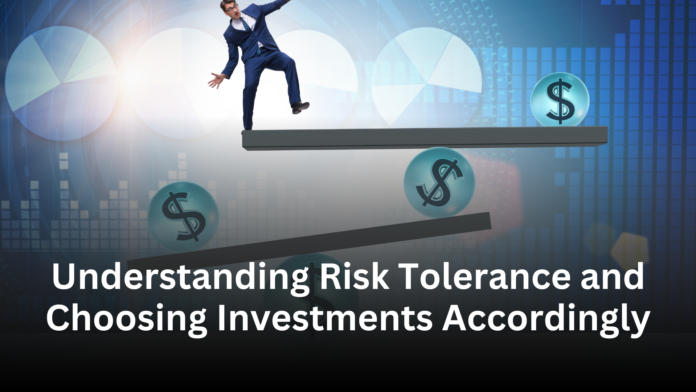Investing can be an exhilarating journey, but it’s not without its risks. Understanding your risk tolerance is crucial in making informed decisions and ensuring that your investment strategy aligns with your financial goals and personal comfort level. This article will delve into what risk tolerance means, how to assess it, and how to choose investments that match your risk profile.
What is Risk Tolerance?
Risk tolerance refers to an individual’s ability and willingness to endure market volatility and potential financial loss. It’s influenced by various factors, including age, financial situation, investment goals, and personal comfort with uncertainty.
Factors Influencing Risk Tolerance
Several factors contribute to determining your risk tolerance:
- Age: Younger investors often have higher risk tolerance because they have more time to recover from potential losses. As investors approach retirement, their risk tolerance typically decreases.
- Financial Situation: Your current financial health plays a significant role. Those with a stable income, emergency funds, and fewer liabilities are usually more open to taking risks.
- Investment Goals: Long-term goals, like retirement, can afford to take on more risk compared to short-term goals, such as buying a house.
- Personal Comfort: Some people are naturally more comfortable with uncertainty and can handle market fluctuations better than others.
Assessing Your Risk Tolerance
To effectively choose investments, you need to assess your risk tolerance accurately. Here are some steps to guide you:
Self-Assessment
Start by asking yourself some key questions:
- How would I react if my investment lost 10%, 20%, or even 50% of its value?
- Am I comfortable with the idea of my investment fluctuating significantly over the short term for the potential of higher returns in the long term?
- How important is liquidity to me? Do I need to access my investment shortly?
Risk Tolerance Questionnaires
Many financial institutions and online platforms offer risk tolerance questionnaires. These tools are designed to evaluate your risk tolerance based on your responses to various scenarios and questions.
Professional Advice
Consider consulting with a financial advisor. They can provide personalized insights and help you understand your risk tolerance more comprehensively.
Choosing Investments Based on Risk Tolerance
Once you have a clear understanding of your risk tolerance, you can start selecting investments that align with your profile.
Low-Risk Tolerance
If you have a low-risk tolerance, you’ll want to focus on investments that offer stability and lower potential for loss. Consider the following options:
Bonds
Bonds are typically less volatile than stocks and provide regular interest payments. Government bonds, in particular, are known for their safety.
Savings Accounts and Certificates of Deposit (CDs)
These are low-risk options that offer fixed returns. They’re ideal for individuals who prioritize capital preservation over high returns.
Dividend-Paying Stocks
These stocks provide a regular income stream through dividends and tend to be less volatile than growth stocks. Companies with a history of consistent dividend payments are often more stable.
Moderate Risk Tolerance
For those with a moderate risk tolerance, a balanced approach combining stability and growth is suitable. Consider these investments:
Balanced Mutual Funds
These funds invest in a mix of stocks and bonds, providing both growth potential and income. They offer diversification, which can help mitigate risk.
Real Estate Investment Trusts (REITs)
REITs allow you to invest in real estate without owning property directly. They offer the potential for appreciation and regular income through dividends.
Blue-Chip Stocks
These are shares in large, well-established companies with a history of reliability. They offer growth potential with relatively lower volatility compared to smaller companies.
High Risk Tolerance
Investors with a high-risk tolerance can afford to pursue investments with higher potential returns but greater volatility. Consider these options:
Growth Stocks
These stocks represent companies expected to grow at an above-average rate compared to other companies. They offer high potential returns but come with significant risk.
Emerging Markets
Investing in developing countries can yield high returns due to rapid economic growth. However, these markets are often more volatile and carry geopolitical risks.
Cryptocurrencies
Cryptocurrencies like Bitcoin and Ethereum offer high return potential but are extremely volatile and speculative. Only consider these if you’re comfortable with significant fluctuations and potential loss.
Diversification: A Key Strategy
Regardless of your risk tolerance, diversification is essential. It involves spreading your investments across various asset classes to reduce risk. A well-diversified portfolio can help manage volatility and protect against significant losses.
How to Diversify
- Asset Allocation: Distribute your investments among different asset classes, such as stocks, bonds, and real estate.
- Geographic Diversification: Invest in both domestic and international markets to reduce exposure to any single economy.
- Sector Diversification: Invest in various industries to avoid sector-specific risks.
Conclusion
Understanding your risk tolerance and choosing investments accordingly is fundamental to successful investing. It ensures that you’re comfortable with your investment choices and can stay the course even during market fluctuations. By assessing your risk tolerance, consulting professionals, and diversifying your portfolio, you can create a strategy that aligns with your financial goals and personal comfort level.

